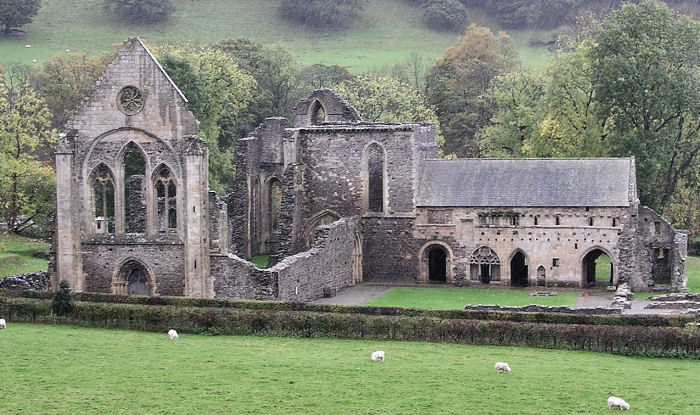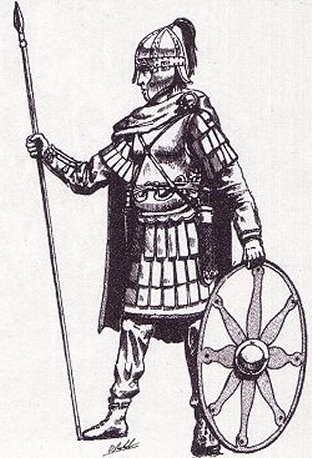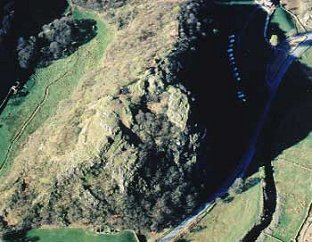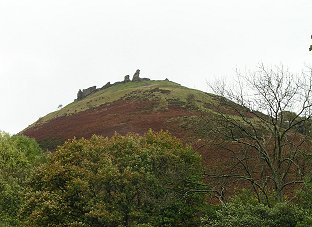Page 3 of 4
Avalon in the New World
Merlin and the Discovery of

Valle Crucis Abbey near the town of Llangollen in North Wales. The present ruins date from around the year 1200, but a monastic building has stood on this spot since the early Dark Ages. It was here that records concerning the legend of Merlin and the two dragons were preserved to be consulted by the ninth-century
monk Nennius and the twelfth-century cleric Geoffrey of Monmouth.
The dragon story was obviously an invention; Ambrosius, however, was not. Like Vortigern, he was an historical figure mentioned by other Dark Age writers. Although he is not record as a wizard, Ambrosius is recorded as uniting Britain in the post-Roman period. The work of a sixth-century monk named Gildas (The Ruin and Conquest of Britain, written around the year 545) refers to Ambrosius as a Roman aristocrat who led the British forces in their war against the invading Anglo-Saxons shortly after Vortigern's reign. Additionally, the English historian Bede (in his Ecclesiastical History of the English Nation, written in 731) says that Ambrosius' family name was Aurelius. The Aurelius family was a powerful Roman dynasty descended from the second-century Roman emperor Marcus Aurelius, and archaeology has shown that when the Roman legions departed members of this family remained in Britain (see here). This Ambrosius Aurelius was therefore undoubtedly an historical figure, and the works of Geoffrey of Monmouth and Nennius taken together imply that Merlin was originally thought to be him.

The Historical Merlin
Illustration by military expert Dan Shadrake, showing Roman armor of the fifth century. This how the historical Merlin, Ambrosius Aurelius, may really have looked.
Why, though, if Ambrosius was the historical figure behind the story of Arthur's wise advisor, has he gone down in legend under the name Merlin? The answer seems to be that the name Merlin was actually a title. Many British warriors of the time adopted the battle names of animals. The monk Gildas, for example, refers to a number of British kings of his time by such titles as the Lion, the Hound and the Leopard. Even the name Arthur seems to have been a title coming from the old British word Arth, meaning Bear. The name Merlin appears to derive from the old British meaning "the Eagle". (In fact, there is still a bird of prey called a merlin to this day.) A number of Dark Age poems are preserved as copies in a medieval manuscript known as The Red Book of Hergest, now in the Bodleian Library at Oxford University. One of these poems clearly demonstrates that Merlin was named after this bird: concerning a prediction Merlin is said to have made, it is entitled The Prophecy of the Eagle.

Ambrosius Aurelius does have many things in common with the Merlin of later romance. Like Merlin, he united Britain in the period after Vortigern's reign: both Gildas and Bede say that he successfully halted the invasion of Britain in the last few decades of the fifth century. There are no such records concerning what actually occurred in Britain immediately after Ambrosius' victories over the Anglo-Saxons, however; but as this is the time Arthur is said to have been king, it might well be that the aging Ambrosius relinquished power in favor of the younger Arthur and remained as his advisor. Also like Merlin, Ambrosius may have been regarded as a mystic.
Illustration of Merlin from Tennyson's Idylls of the King, 1898. In legend Merlin was not only depicted as a wizard but also a bard - a poet and writer of songs. In the Dark Ages bards were accredited with the gift of prophecy.
Surviving writings concerning Britain in the Dark Ages are found mainly in Welsh manuscripts and in the Welsh language. The reason being that by the seventh century the Anglo-Saxons had resumed their offensive and successfully conquered what is now England. The native Britons were forced to retreat west, into what is now Wales. It was therefore here that most records concerning the earlier Dark Age period survived. The Welsh language developed directly from Brythonic, the language spoken throughout much of Britain in the immediate post-Roman period, while English developed from the language of the Anglo-Saxons. As the Welsh language had very different inflections to the English and Latin tongues, the Welsh had their own rendering of both Roman and English names, making them easier to pronounce. In Welsh writings the name Merlin appears as Myrddin, and Ambrosius is rendered as Emrys.(Ambrosius Aurelius is referred in Dark Age Welsh documents as Emrys Gwledig – "Prince Emrys".) One Dark Age Welsh reference actually links the names Myrddin and Emrys together. In a list of bards (Dark Age British poets) found in The Red Book of Hergest, one of the bards is called Myrddin Emrys – Merlin Ambrosius (see Triad 87). If this is the same person as Ambrosius Aurelius, then it means that the Britons at the time would almost certainly have regarded him as having mystical powers. Although today the word bard is associated simply with poets, during the Dark Ages bards were also accredited with the gift of prophecy, as was Merlin in the Arthurian Romances.

The Bodleian Library, Oxford, where The Red Book of Hergest is now preserved. In this manuscript there can be found a Dark Age reference to Merlin under the name Merlin Ambrosius.

So where did this Merlin/Ambrosius live? According to Geoffrey of Monmouth, Vortigern gave Merlin his fort on a mountain in North Wales. Today, there is an identifiable location that might have been the mountain in question. A mountain in the North Wales Snowdonia range is still called Dinas Emrys – Fort Ambrosius. In the 1950s excavations near the summit uncovered the remains of a post-Roman fortification built sometime in the mid-to-late 400s, precisely the time Vortigern is known to have reigned and Merlin is said to have lived. There is, however, a more likely location.
The mountain of Dinas Bran (named after a pre-Christian Celtic god) stands close to the English Welsh border near the North Wales town of Llangollen. The ruins of the castle that still survive on the summit date from the thirteenth century, but archaeology has revealed that the hilltop had been fortified for many centuries before that. The earliest fort dates from around the mid fifth century so, like Dinas Emrys, it was probably built during Vortigern’s time. What makes this a more probable location for the fort in the story of Merlin and the two dragons is that it directly overlooks the heart of Vortigern’s kingdom in what is now Shropshire, just over five miles to the south-east. This is strategically a more feasible site: it stands on the edge of the Welsh Mountains, whereas Dinas Emrys, although possibly later used by Ambrosius to protect the Welsh coast from incursions by invaders from Ireland, is over fifty miles further west, on the other side of the Welsh mountains in an area the Anglo-Saxon’s never threatened.

Aerial photograph of Dinas Emrys mountain in North Wales. In Welsh Dinas Emrys means Fort Ambrosius.

The ruined fortifications on Dinas Bran. Was this the home of the historical Merlin?
So it seems that the story of Merlin was based on the life of Ambrosius Aurelius, an historical figure who united the Britons in the mid-to-late fifth century. He could well have been advisor to his successor King Arthur and, if he was a bard, he would have been accredited with the gift of prophecy.








